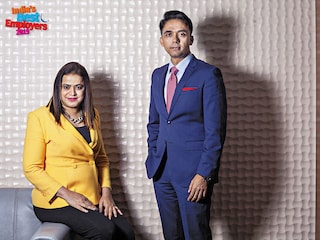At Tata AIA, employees are all in it together
Tata AIA Life Insurance has grown as an organisation by helping its employees prosper


This is reflected formally in the company’s HR policies and manifests itself across the organisation. Formally, it comes in the form of ‘Career Shaper’, a ‘competency dictionary’, where every role in the company has been mapped to a set of competencies along with proficiency levels for them. It also has pyramids that display not just a vertical career path, but also horizontal movements to other verticals in the company, helping people grow.
“We deliver our employees’ aspirations and ambitions, because we look for potential. We focus on catching people doing things right rather than catching people doing things wrong,” says Kristyl Bhesania, executive president and head HR at Tata AIA. Take for instance, Shibani Deshmukh, a doctor who worked on designing insurance products at the company but was also interested in doing something related to corporate social responsibility (CSR) and people. She spoke to Bhesania and moved to HR.
“As Tata AIA allows vertical and horizontal growth, and has several programmes to develop and grow talent and careers, it tends to develop a flexible range of capabilities that would enable managers with suitable potential to move into a variety of positions, [their] skill and know-how permitting, though” says S Raghunath, professor, strategy, Indian Institute of Management-Bangalore (IIM-B).
Besides career planning, there’s also succession planning. “We have a structured succession planning process called the OPR, the Organisation People Review process. Our senior leadership talent is part of this process, which charts ready successors at all levels,” says Bhesania.
An example of this is when the previous CEO and MD Naveen Tahilyani moved on to the role of chief executive officer, group partnership distribution, AIA Group, Hong Kong, last year, Srivastava was a ready successor. “We had a ready successor [for Tahilyani], and likewise for Rishi we also had a successor who could take over the role. So we have a bench strength of successors for all roles,” says Bhesania, who joined Tata AIA in 2012 and has since been implementing various initiatives. “At Tata AIA, we have built a high-performance work culture. And a company with a mind and a heart when it comes to people, highly professional, focussed on delivery and business results, and yet with a heart, where we care for people,” says Bhesania.
Once a person is on the job, there are recognition processes, fun-at-work initiatives, a work-from-home policy and an e-learning platform called Gurucool. Considering 81 percent of the company’s employees are millennials, there is an HR chatbot called Good Buddy, where employees can connect with their colleagues as well as access HR processes online.
The attrition rate has dropped to 21 percent overall, and top talent attrition as of March 2019 was at 6.1 percent, “which is an all-time low from all the years that Tata AIA has been in existence”, says Bhesania. And for people who leave, there’s a fond farewell, as well as an initiative called ‘Homecoming’—people are welcome to come back.
The initiatives speak through other figures as well. In 2013, the company ranked at number 17 in the life insurance business. Today it is at number 5, based on individual weighted new business premium estimates in the industry. “And since we are a growing organisation we have opportunities for our internal talent to grow within the organisation and have a robust capability building plan to grow talent to cater to our growth requirements,” says Bhesania adding that everyone goes through various development initiatives. “My entire executive committee, who report to the MD, went through an Enterprise Leadership Programme—ELP—at Insead in July 2017 on Senior Leadership Development at the enterprise level,” she points out.
At the heart of being a good employer, says Srivastava, are three things. “One is that you acknowledge the fact that people spend more time, their awake time, in the workplace than at home second, everyone who comes out to work wants to succeed.” And third, clarity about what they want to do, where their heart lies, or what drives them, and helping them develop accordingly. “It is keeping these three things in mind that we have developed the culture,” he says.
First Published: Aug 14, 2019, 09:25
Subscribe Now